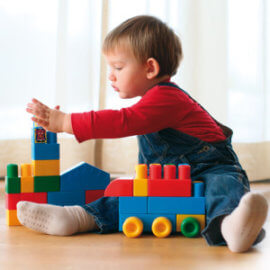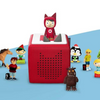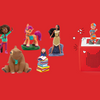How to support child development through play?

Play is an inseparable element of human life. It appears very early, because in infancy. It is thanks to the fun that children will get to know the world around them in a pleasant way.
Play helps them to develop intellectually, emotionally, aesthetically, physically and spiritually. It teaches how to function in society and relationships with others. It creates character and attitude towards the world in a child. One would be tempted to say that he teaches life.
Play can not be treated as a filler of time. It should be creative to support the child at every stage of its development.
Games can be divided into several types that are very easy to observe during the child's development.
We distinguish fun:
1. Manipulation
They teach control over their own body. They appear at the earliest. They rely on the manipulation of the object in various ways, watching, licking, sucking, translating from hand to hand, inserting and removing, rolling, etc. This type of fun is aimed at learning about the properties of objects: shape, consistency or sound. The child manipulates objects by engaging visual, auditory, tactile observations and complex hand movements. This stage is the basis for later, more complicated games.
Examples of games:
Various invoices - play for babies and toddlers.
Prepare pieces of materials with different textures, artificial fur, velvet, fine sandpaper, velcro, cardboard, bubble wrap, etc. Let the child touch various textures. Describe to your child every material saying that something is soft, rough, slippery, etc.
Unload and load - fun for children from the first year of life.
Children love to put in and take out items. They are fascinated by the fact that in one moment something can be full and empty in the next. A box with blocks is enough for this fun. Sprinkle the blocks on the floor and encourage the child to put them in the box, demonstrate to the child how to do it. Once the blocks are inside, show your child how to sprinkle them back. Talk to the child about the colors of the blocks.
Tear it! - play for children from the first year of life.
Toddlers love to tear things. Make sure that the texture is varied, give your child an old newspaper, tissue paper, wax breakfast paper or paper towels. When the child is busy with the torn paper, talk to him about the feelings he is experiencing: "Is not this tissue paper soft?", "I think this breakfast paper is very slippery."
Remember that younger kids love to take everything into their mouth. Make sure your child does not eat paper.
What is it - fun for children from the age of two.
Encourage your child to play guessing. You will need a medium-sized carton with a lid. On the side wall, make a hole big enough for the child to put his hand inside, but not his head. Insert various items in succession, such as chalk, spoon, cup, comb, book. Let the child try to recognize the object only by touch and say what it is for.
2. Constructional
Stimulate the imagination. The constructional fun exercises the child's manual efficiency and awaken his creativity. They rely on building, creating something new. They naturally result from manipulation games. They differ, however, in the construction of a product that is the result of the child's actions. These types of games improve perceptual-motor development. They trigger ingenuity, implement to focus attention, teach observation. The most popular constructional toy are blocks. With their help, the child builds his own reality using unlimited imagination. Each design is unique and gives the child a lot of joy.
Examples of games:
Connecting elements - fun for older kids, from the second year of life.
Thicken out basic thick shapes (squares, triangles, etc.) or shapes of animals or objects (eg car) from thick colored cardboard. Using a hole punch that makes individual holes, make holes in cardboard boxes anywhere, taking care not to be too close to yourself or the edge. Pass the shoelace through the first hole and fasten it, tying it on the knot so that it does not run away from the child while playing. It's good that the color of the lace contrast with the pattern. Show your child how to thread the shoelace through the hole, and then let him train yourself. It is a great exercise for learning to thread and tie shoes. All you need is a suitable foot shape.
We make a cake - fun for older kids, from the second year of life.
Children love playing in the kitchen. Let your child help you prepare the cake. You will need: 1 glass of salt, 4 glasses of flour, 1 glass of warm water. In a bowl, mix salt with flour and add water. Knead the dough until it is soft. Encourage your child to knead the dough and create different shapes.
Such play develops precise motor skills. After finishing the game, put the dough in a sealed container.
Wazonik - fun for older kids, from the second year of life.
For this fun, prepare a small jar, plasticine, multicolor beads, buttons, shells, small plastic flowers, etc. Show your child. how to stick a jar with plasticine from the outside, when you are done, let the child decorate the vase according to your preferences. In such a vase you can store a flower made on a different occasion.
Corals - fun for older kids, from the second year of life.
Who of us did not make pasta noodles in childhood? It is an irreplaceable fun to train motor skills, and it gives a lot of joy when the child carries a hand-made necklace around his neck.
You will need a string / shoelace and a tube-type pasta for this fun. Thread the first pasta and tie at the end of the knot. Show your child how to thread pasta on a thread. Observe the focus on the child's face.
3. Themed
Socializing. In this type of games, the child imitates the activities observed in his environment. Often does not even need toys, rich imagination allows children to accurately pretend to perform certain activities specific to the role. The most important feature of this game is its theme, children play in something: home, shop, school. In the youngest children, the subject is often limited to one element, such as cooking dinner. An important component of thematic games are verbal statements of the child. The child conducts monologues or dialogues, taking two roles simultaneously. These types of games are very important for the child's development because they combine all physical and mental functions. Children usually start this kind of fun by themselves.
Examples of games:
Play in cooking
A child using pots of toys and imitations of food products (fruits, vegetables) imitates cooking dinner. For the youngest children, a pot and a spoon are enough to play in cooking.
Play at the doctor
The child with great care bandages the mate's paw or makes cold wraps of the feverish doll.
4. Rhythmic-movement
They exercise fitness and strengthen strength. These games are the natural activity of every child and satisfy the need for movement. Children practice their fitness, dexterity, strength, speed, sense of rhythm. If the game takes the form of a sports competition, teaches children healthy and pleasant competition and strengthens faith in themselves. The most popular movement games are ball games, dancing, jumping, climbing or berek.
Examples of games:
Bouncing ball - fun for babies.
You will need a large exercise ball. Hold the child when sitting on the ball and gently jump up with the child on the ball up and down. Lay the baby on the tummy and gently roll back and forth.
Dancing with falling - fun for older kids, from the second year of life.
Toddlers love to spin around and fall to the ground. Let live music and invite your child to dance. When the music stops, throw yourself to the ground. Repeat the game as long as the child wants it. Instead of falling to the ground, you can wave your hands, clap or jump.
5. Research
They satisfy the natural curiosity of the world. These types of games are the result of a natural child's need to learn about the world around them. Children perform various experiments on various materials or toys. These games allow the child to discover and learn in a pleasant way.
Examples of games:
On / off - fun for younger kids, from the first year of life.
For this play, prepare mechanical toys with switches, a flashlight. Encourage children to experiment with switches, describe and discuss what happens when a child presses a button. Demonstrate this fun also on the light switches.
Ping-pong chimney - fun for older kids, from the second year of life.
You will need empty paper tubes after kitchen foils or paper towels. Show your child how to lean the tube against the wall or attach it to the railing or fence. The child, putting the ball from the top, observes how it flies out at the bottom.
Experiment with launching - fun for older kids, from the second year of life.
Prepare a small bathtub or bucket with water and all sorts of things: blocks, large plugs, sponge balls, plastic caps, sponges. Explain to the child the principle of playing with water, remind that the water is to stay in the tub / bucket. Put all the objects within the reach of the child and encourage the child to check which objects are drowning and which are swimming. Follow and discuss the results with your child, ask which items are light and which are heavy.
6. Didactic
They have learning values. These types of games are deliberately organized by adults in order to teach children new skills and knowledge about the world. Children try to focus their attention on the tasks assigned to them, trying to reason properly, analyze and synthesize them, distinguish and compare the features of various objects.
Examples of games:
Tracker shapes - fun for children from the age of two.
Collect several items (eg a block, a rubber mallet, a slipper or a fairy tale) and outline their shapes on a piece of paper. Put items in front of the child and encourage them to find their shapes.
Covering for breakfast - fun for children from the age of two.
We start the game by talking to the child about what we eat for breakfast and which dishes we use. We will need a set of dolls' dishes (plates, cups, spoons and napkins). We sit on dolls / teddy bears on children's chairs. With each of them, arrange a plate, a cup, a teaspoon, etc. Then, we ask the child to listen to what the dolls ask for, we put our ear to one of them and listen and then we loudly say what the doll asked for. And in this way the child has the task of completing the missing dishes for all the dolls. Now it's time to start the breakfast, the child has the task of feeding the dolls, and at the end you play in cleaning and arranging the dishes on the shelf.
What has changed - fun for children from the age of three.
We arrange several well-known items / toys in front of the child. Then, please, close your eyes and take one item. The child's task is to guess what has disappeared. In addition, we will make the task difficult if we change the order in which the items are arranged.
We must remember that the child is different and develops at his own pace. For children of the same age, different games can be attractive, easy or difficult. Always try to match the games to the tastes and abilities of our child and remember that learning through play is to be primarily pleasing to the child.
All the best,




